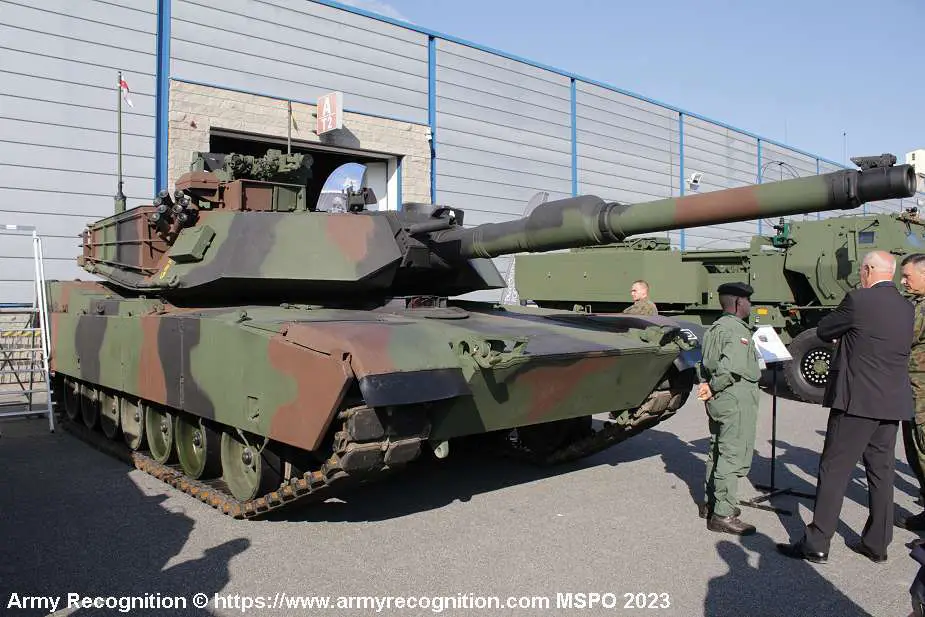Breaking news
MSPO 2023 highlights new M1A1 Abrams tanks of Polish army.
At the MSPO 2023 event, Poland showcases its recently acquired M1A1 Abrams tank, one of several foreign tank models procured to modernize and augment its tank inventory. Over the past few months, Poland has provided Ukraine with a substantial number of tanks, primarily consisting of Russian-made T-72 and Polish-made PT-91 Twardy. To replace these, Poland has placed significant orders for American-made M1A1 and M1A2 SEPv3 tanks, as well as K2 tanks developed in South Korea.
Follow Army Recognition on Google News at this link

MSPO 2023 highlights M1A1 Abrams tanks recently acquired by Poland (Picture source: Army Recognition)
On December 6, 2022, the US State Department granted approval for a Foreign Military Sale (FMS) agreement between the United States and Poland, valued at an estimated $3.75 billion. This comprehensive contract encompasses various components, including 116 M1A1 Abrams Main Battle Tanks tailored to meet the specific requirements of the Polish Army.
These acquisitions follow Poland's prior procurement of 250 M1A2 SEP v.3 Abrams tanks in April 2022, with deliveries slated for 2025-2026. However, there is potential for expedited delivery of the initial vehicles. The total cost for these tanks amounted to $4.75 billion and included supporting equipment and vehicles, along with a training and logistics package, and ammunition reserves. Furthermore, in 2022, based on a separate agreement, the United States Army relocated 28 M1A2 SEP v.2 Abrams tanks to Polish territory, along with instructors to provide training for Polish crews, as part of the ABRAMS Academy established at the Land Forces Training Center in Poznań.
On June 29, 2023, the Army Recognition editorial team reported that Poland received its initial shipment of these M1A1 Abrams tanks, comprising an initial batch of 14 tanks, delivered at the Polish harbor of Szczecin. This delivery also included 3 M88A2 Hercules vehicles and spare parts.
The M1A1 Abrams, a Main Battle Tank manufactured by the American defense company General Dynamics Land Systems (GDLS), entered service in 1985 as an upgraded version of the original M1 Abrams tank, which had been introduced in 1980. The M1A1 boasted several enhancements over its predecessor, including a more potent engine, improved armor protection, and numerous upgrades to its weapon systems and electronics. Its combat debut occurred during the Gulf War in 1991, where it showcased its supremacy over Iraqi armor, solidifying its status as one of the world's most advanced and effective main battle tanks.
The primary armament of the M1A1 Abrams comprises a 120mm M256 smoothbore main gun, capable of firing various ammunition types, including armor-piercing fin-stabilized discarding sabot (APFSDS) rounds, high-explosive anti-tank (HEAT) rounds, and high-explosive squash head (HESH) rounds. This gun offers precise fire even while on the move, making it a formidable asset against stationary and mobile targets alike.
Complementing the main gun is a coaxial 7.62mm M240 machine gun, operated by the tank commander. Additionally, the M1A1 features a pintle-mounted 12.7mm M2 machine gun atop the turret, which can be operated by the loader.
The tank's armor is constructed of composite layers comprising steel, ceramics, and depleted uranium, with particularly robust frontal armor, providing protection against heavy armor-piercing rounds and high-velocity projectiles. The option for explosive reactive armor (ERA) on the sides and turret further bolsters defense capabilities.
The M1A1 Abrams tank is powered by a Honeywell AGT-1500 gas turbine engine, granting it a top speed of approximately 72 km/h on roads and an impressive range of up to 426 km on a single tank of fuel. Renowned for its reliability and minimal maintenance requirements, this gas turbine engine is ideally suited for extended use in demanding combat environments.
Augmented by an advanced suspension system comprising torsion bars and hydraulic shock absorbers, the M1A1 can navigate challenging terrains with ease, including steep gradients and obstacles such as ditches and trenches, rendering it highly effective in both offensive and defensive operations.






















